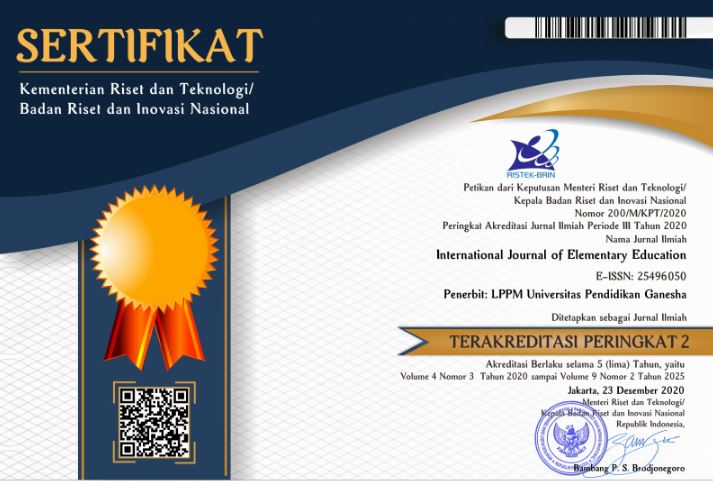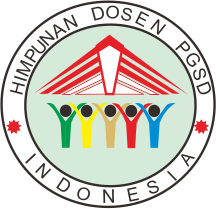The Effectiveness of Game Based Learning Utilizing Snakes and Ladders Media on Javanese Script Learning Outcomes
DOI:
https://doi.org/10.23887/ijee.v8i3.78934Keywords:
Game Based Learning, Learning Media, Snakes and Ladders, Javanese Script, Writing CompetencyAbstract
This research is motivated by students' difficulties in writing Javanese script. The purpose of this research is to determine the effectiveness of using a game-based learning model using a snakes and ladders media on students' learning outcomes in writing Javanese script in fifth grade. The type of research used is quantitative research with an experimental method. The research design uses a quasi-experimental design with the type of research being one group pretest-posttest design. The population and sample in this research were fifth grade students totaling 27 students. The sampling technique in this research uses purposive sampling technique, where samples are taken with certain criteria. Data collection methods in this research were observation, tests, and documentation. Based on the research results, a paired sample t- test was obtained at 0.000 and an N-Gain test at 0.5321. The results of the data analysis indicate that the game-based learning model mediated by snakes and ladders is effective enough to improve students' learning outcomes in writing Javanese script. Thus, it is expected that the game-based learning model using snakes and ladders media can have a positive impact on improving learning outcomes in writing Javanese script.
References
Ahmad, I. F., Setiawati, F. A., Prihatin, R. P., Fitriyah, Q. F., & Thontowi, Z. S. (2024). Technology-based learning effect on the learning outcomes of Indonesian students: a meta-analysis. International Journal of Evaluation and Research in Education , 13(2), 892–902. https://doi.org/10.11591/ijere.v13i2.25383.
Alenezi, A. (2020). The role of e-learning materials in enhancing teaching and learning behaviors. International Journal of Information and Education Technology, 10(1), 48–56. https://doi.org/10.18178/ijiet.2020.10.1.1338.
Anggraini, H. I., Nurhayati, & Kusumaningkrum, S. R. (2021). Penerapan media pembelajaran game matematika berbasis hots dengan metode digital game based learning di sekolah dasar. Jurnal Pendidikan Indonesia (Japendi), 2(11). https://doi.org/10.59141/japendi.v2i11.356.
Chang, W. L., & Yeh, Y. chu. (2021). A blended design of game-based learning for motivation, knowledge sharing and critical thinking enhancement. Technology, Pedagogy and Education, 30(2), 271–285. https://doi.org/10.1080/1475939X.2021.1885482.
Fauziyah, N. I. H., & Anugraheni, I. (2020). Pengaruh Model Pembelajaran TGT (Teams Games Tournament) Ditinjau dari Kemampuan Berpikir Kritis Pada Pembelajaran Tematik di Sekolah Dasar. Jurnal Basicedu, 4(4), 850–860. https://doi.org/10.31004/basicedu.v4i4.459.
Ghafar, Z. N., Hassan, M., & Sawalmeh, M. (2023). Journal of World Englishes and Educational Practices Use of Language Games to Facilitate Grammar Learning by ESL/EFL Students: A Literature Review. Journal Od World English and Educational Practices, 5(2). https://doi.org/10.32996/jweep.
Gyaurov, D., Fabricatore, C., & Bottino, A. (2022). Features of Entertainment Digital Games for Learning and Developing Complex Problem-Solving Skills: A Protocol for a Systemic Review. International Journal of Qualitative Methods, 21. https://doi.org/10.1177/16094069221128491.
Hapsari, E. D., Yuda, Y. P., & Suci, C. R. (2022). Efektivitas Penggunaan Media Pembelajaran Menulis Aksara Jawa Berbasis Mobile terhadap Prestasi Siswa. Edusaintek: Jurnal Pendidikan, Sains Dan Teknologi, 9(2), 351–361. https://doi.org/10.47668/edusaintek.v9i2.475.
Hari Pujayanti, F., Sumiharsono, R., & Triwahyuni, E. (2023). Pengaruh Metode Game Based Learning terhadap Kemampuan Motorik Kasar dan Kemampuan Sosial Emosional Anak TK. EDUKASIA: Jurnal Pendidikan Dan Pembelajaran, 4(2), 1435–1444. https://doi.org/10.62775/edukasia.v4i2.458.
Hilman, Y. (2022). Pengaruh Penalaran Siswa Terhadap Kemampuan Menulis Teks Deskripsi Dalam Pembelajaran PjBL. Bahtera Indonesia; Jurnal Penelitian Bahasa Dan Sastra Indonesia, 7(2), 446–455. https://doi.org/10.31943/bi.v7i2.242.
Ilawaty, S. A. (2023). Penerapan Metode Pembelajaran Diskusi dan Penemuan Terbimbing (Discovery) dalam Upaya Meningkatkan Motivasi Belajar Matematika pada Materi Persamaan Lingkaran. Jurnal Multidisiplin Indonesia, 2(3), 565–579. https://doi.org/10.58344/jmi.v2i3.195.
Irhandayaningsih, A. (2020). Pengukuran Literasi Digital Pada Peserta Pembelajaran Daring Di Masa Pandemi Covid-19. Anuva, 4(2), 231–240. https://demo.dspacedirect.org/bitstream/handle/10673/1975/8073-25123-1-SM.pdf?sequence=1&isAllowed=y.
Jamalin, F., & Abdul, A. (2021). Arabic-Java writing system: how Javanese language adopts Arabic Script. Journal of Arabic Language Teaching, Linguistics, and Literature, 4, 43–58. https://ejournal.umm.ac.id/index.php/izdihar/article/view/11337.
Kadnawi, & Fanani, M. R. (2022). The Implementation of Using Snake and Ladder Game onSpeaking Program at Genta English Course Pare - Kediri. Journal of English Education, Literature, and Linguistics, 2(1). https://doi.org/10.55148/etjar.v2i1.284.
Kuncoro, A. (2024). The Snakes and Ladders Game: Developing the Early Childhoods’ Cognitive Ability at Cendrawasih II Kindergarten. Journal Corner of Education, Linguistics, and Literature, 3(4), 446–451. https://doi.org/10.54012/jcell.v3i4.303.
Kusuma, F. E. E., Setyawan, M. B., & Zulkarnain, I. A. (2019). Penerapan Teknologi Augmented Reality Berbasis Android Sebagai Media Pembelajaran Pengenalan Aksara Jawa di SDN 1 Sidorejo Ponorogo. KOMPUTEK: Jurnal Mahasiswa Universitas Muhammadiyah Ponorogo, 3(1), 61–67. https://doi.org/10.58258/jupe.v7i2.3849.
Lawn, S., Zhi, X., & Morello, A. (2017). An integrative review of e-learning in the delivery of self-management support training for health professionals. BMC Medical Education, 17(1), 1-16. https://doi.org/10.1186/s12909-017-1022-0.
Liu, Z. Y., Shaikh, Z. A., & Gazizova, F. (2020). Using the concept of game-based learning in education. International Journal of Emerging Technologies in Learning, 15(14), 53–64. https://doi.org/10.3991/ijet.v15i14.14675.
Ma’ratusholihah, Priyanto, & Damayani, A. . (2019). Pengembangan media pembelajaran tematik ular tangga berbagai pekerjaan. Mimbar PGSD Undiksha, 7(3). https://doi.org/10.23887/jjpgsd.v7i3.19411.
Maharani, Aminuyati, Wiyono, H., Buwono, S., & Karolina, V. (2024). Efektivitas Model Pembelajaran Game-Based Learning terhadap Hasil Belajar Peserta Didik pada Pembelajaran IPS Kelas VII SMP Negeri 6 Pontianak. Journal on Education, 06(03), 16677–16684. https://doi.org/https://doi.org/10.31004/joe.v6i3.5403.
Mustafidah, N. M., Susandi, A., Huda, N., Hayati, H., & Susanto, A. (2022). The Use of Problem-Based Learning Method to Improve Student’s Critical Thinking Skills. CONCIENCIA: Journal of Islamic Education, 22(2), 56–64. https://doi.org/https://doi.org/10.19109/conciencia.v22i2.14305.
Novita, L., & Sundari, F. S. (2020). Peningkatan Hasil Belajar Siswa Menggunakan Media Game Ular Tangga Digital. Jurnal Basicedu, 4(3), 716–724. https://doi.org/10.31004/basicedu.v4i3.428.
Nur, K., Muis, A., & Mulianti. (2023). Upaya Meningkatkan Keaktifan Peserta Didik Mengikuti Proses Pembelajaran melalui Game Based Learning (GBL) di UPT SMA Negeri 1 Bone Karyati. Jurnal Pemikiran Dan Pengembangan Pembelajaran Upaya, 5(3), 576–582. https://doi.org/https://doi.org/10.31970/pendidikan.v5i3.910.
Permana, N. S. (2022). Game Based Learning sebagai Salah Satu Solusi dan Inovasi Pembelajaran bagi Generasi Digital Native. Jurnal Pendidikan Agama Katolik (JPAK), 22(2). https://doi.org/10.12681/edusc.3109.
Praheto, B. E., & Utomo, F. B. B. (2020). Metode Transliterasi untuk Meningkatkan Kemampuan Membaca Aksara Jawa di Program Studi Pendidikan Guru Sekolah Dasar. Jurnal Nalar Pendidikan, 8(1). https://doi.org/10.26858/v8i1.11524.
Putra, E. D., Sullystiawati, L. H., & Sari, Y. I. (2023). Pendampingan Inovasi Pembelajaran Matematika SMP Melalui Permainan Ular Tangga Berbasis Etnomatematika. Dedication : Jurnal Pengabdian Masyarakat, 7(1), 119–128. https://doi.org/10.31537/dedication.v7i1.1034.
Rahayu, A. R. D., Febriandi, R., & Egok, A. S. (2022). Pengembangan Media Ular Tangga pada Pembelajaran Tematik Kelas IV SD Negeri Sungai Jauh. Linggau Jurnal of Elementary School Education, 2(2), 1–14. https://doi.org/https://doi.org/10.55526/ljese.v2i2.269.
Ramadhansyah, A. A., Mulyana, Ulfa, T., & Miftakhuddin. (2022). Eight Javanese teaching issues and its possible solutions: A systematic literature review. Journal of Innovation in Educational and Cultural Research, 3(2), 162–176. https://doi.org/10.46843/jiecr.v3i2.78.
Rasyidi, M. A., Bariyah, T., Riskajaya, Y. I., & Septyani, A. D. (2021). Classification of handwritten javanese script using random forest algorithm. Bulletin of Electrical Engineering and Informatics, 10(3), 1308–1315. https://doi.org/10.11591/eei.v10i3.3036.
Ren, J., Xu, W., & Liu, Z. (2024). The Impact of Educational Games on Learning Outcomes: Evidence From a Meta-Analysis. International Journal of Game-Based Learning, 14(1), 1–25. https://doi.org/10.4018/IJGBL.336478.
Rosarian, A. W., & Dirgantoro, K. P. S. (2020). Upaya Guru Dalam Membangun Interaksi Siswa Melalui Metode Belajar Sambil Bermain [Teacher’S Efforts in Building Student Interaction Using a Game Based Learning Method]. JOHME: Journal of Holistic Mathematics Education, 3(2), 146. https://doi.org/10.19166/johme.v3i2.2332.
Shemshack, A., & Spector, J. M. (2020). A systematic literature review of personalized learning terms. Smart Learning Environments, 7(1). https://doi.org/10.1186/s40561-020-00140-9.
Siagian, M. V, Saragih, S., & Sinaga, B. (2019). Development of learning materials oriented on problem-based learning model to improve students’ mathematical problem solving ability and metacognition ability. International Electronic Journal of Mathematics Education, 14(2), 331–340. https://doi.org/https://doi.org/10.29333/iejme/5717.
Sulasih. (2021). Peningkatan Hasil Penilaian Pengetahuan Muatan Lokal Bahasa Jawa Tentang Memahami Pasangan Huruf Jawa Melalui Modeling The Way dengan Flashcard pada Peserta Didik Kelas V SD Negeri 2 Kalanglundo. Jurnal Inovasi Pendidikan Bahasa Dan Sastra, 1(2), 133. https://doi.org/https://doi.org/10.51878/language.v1i2.658.
Syaikhu, A. A., Pranyata, Y. I. P., & Fayeldi, T. (2022). Pengembangan Media Pembelajaran Matematika Electronic Snake and Ladder Pada Game-Based Learning. Journal Focus Action of Research Mathematic (Factor M), 5(1), 14–30. https://doi.org/10.30762/f_m.v5i1.629.
Thaha, R. M., Farid, J. A., Rachmat, M., Manyullei, S., & Nasir, S. (2022). The Effect of Education Using Snakes and Ladders Board Game on Healthy Snacks Selection of Elementary School Students. Open Access Macedonian Journal of Medical Sciences, 10(E), 465–470. https://doi.org/10.3889/oamjms.2022.8327.
Tholibon, D. A., Nujid, M. M., Mokhtar, H., Rahim, J. A., Rashid, S. S., Saadon, A., Tholibon, D., & Salam, R. (2022). The factors of students’ involvement on student-centered learning method. International Journal of Evaluation and Research in Education, 11(4), 1637–1646. https://doi.org/10.11591/ijere.v11i4.22314.
Tong, D. H., Uyen, B. P., & Ngan, L. K. (2022). The effectiveness of blended learning on students’ academic achievement, self-study skills and learning attitudes: A quasi-experiment study in teaching the conventions for coordinates in the plane. Heliyon, 8(12), e12657. https://doi.org/10.1016/j.heliyon.2022.e12657.
Videnovik, M., Vold, T., Kiønig, L., Madevska Bogdanova, A., & Trajkovik, V. (2023). Game-based learning in computer science education: a scoping literature review. In International Journal of STEM Education (Vol. 10, Issue 1). Springer Science and Business Media Deutschland GmbH. https://doi.org/10.1186/s40594-023-00447-2.
Walidah, A. K., & Sukartono. (2024). Implementasi Media Kartu Huruf dalam Pembelajaran Aksara Jawa Kelas 3 Sekolah Dasar. Jurnal Kependidikan, 13(2). https://doi.org/https://doi.org/10.58230/27454312.697.
Wandini, R. R., Damanik, E. S. D., Daulay, S. H., & Iskandar, W. (2021). The Effect of Snake and Ladder Game on Student Learning Outcomes in Studying Islamic History “Fathu Mecca” at The Elementary School Muhammadiyah, North Sumatera, Indonesia. Al-Bidayah : Jurnal Pendidikan Dasar Islam, 13(1), 167–178. https://doi.org/10.14421/al-bidayah.v13i1.637.
Wardia, W., Setyosari, P., & Ulfa, S. (2022). Efektivitas Penggunaan Game Based Learning Untuk Meningkatkan Hasil Belajar Hukum Bacaan Tanwin Siswa Kelas VII SMP. JKTP: Jurnal Kajian Teknologi Pendidikan, 5(4), 337. https://doi.org/10.17977/um038v5i42022p337.
Wati, A. (2021). Pengembangan Media Permainan Ular Tangga untuk Meningkatkan Hasil Belajar Siswa Sekolah Dasar. Mahaguru: Jurnal Pendidikan Guru Sekolah Dasar , 2(1), 68–73. https://doi.org/10.33487/mgr.v2i1.1728.
Widhiarso, W., & Ravand, H. (2014). Estimating reliability coefficient for multidimensional measures. A pedagogical illustration. Review of Psychology, 21(2), 111–121.
Widiana, I. W., Parera, N. P. G., & Yuda Sukmana, A. I. W. I. (2019). Media Permainan Ular Tangga Untuk Meningkatkan Hasil Belajar Siswa Kelas IV Pada Kompetensi Pengetahuan IPA. Journal of Education Technology, 3(4), 315–322. https://doi.org/10.23887/jet.v3i4.22556.
Widiyono, Y., Setyowati, H., & Aryanto, A. (2022). Strategi transliterasi untuk meningkatkan kemampuan membaca dan menulis aksara Jawa bagi mahasiswa. Jurnal Pendidikan Surya Edukasi (JPSE), 8. https://doi.org/10.37729/jpse.v8i1.2062.
Williams, M. K., Foulger, T. S., & Wetzel, K. (2009). Preparing Preservice Teachers for 21st Century Classrooms: Transforming Attitudes and Behaviors About Innovative Technology. Journal of Technology and Teacher Education, 17(3), 393–418. https://www.learntechlib.org/primary/p/28216/.
Yulinar, D., Tandililing, E., & Mahmuda, D. (2019). Efektifitas Penggunaan Media Ular Tangga Untuk Meningkatkan Hasil Belajar Peserta Didik Materi Suhu. Jurnal UNTAN, 8(6), 1–9. https://doi.org/http://dx.doi.org/10.26418/jppk.v8i6.33428.
Żammit, J. (2022). Is mobile game-based learning effective for international adults learning Maltese? Asian-Pacific Journal of Second and Foreign Language Education, 7(1). https://doi.org/10.1186/s40862-022-00157-2.
Downloads
Published
How to Cite
Issue
Section
License
Copyright (c) 2024 Citra Dwi Fitriani, Nur Hanifah Insani

This work is licensed under a Creative Commons Attribution-ShareAlike 4.0 International License.
Authors who publish with the International Journal of Elementary Education agree to the following terms:
- Authors retain copyright and grant the journal the right of first publication with the work simultaneously licensed under a Creative Commons Attribution License (CC BY-SA 4.0) that allows others to share the work with an acknowledgment of the work's authorship and initial publication in this journal.
- Authors are able to enter into separate, additional contractual arrangements for the non-exclusive distribution of the journal's published version of the work (e.g., post it to an institutional repository or publish it in a book), with an acknowledgment of its initial publication in this journal.
- Authors are permitted and encouraged to post their work online (e.g., in institutional repositories or on their website) prior to and during the submission process, as it can lead to productive exchanges, as well as earlier and greater citation of published work. (See The Effect of Open Access)








